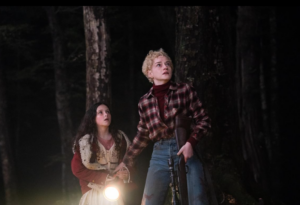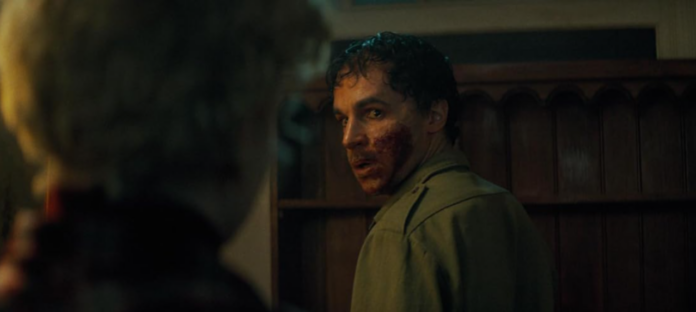Directed by Leigh Whannell — known for Saw (2004) and The Invisible Man (2020) — Wolf Man (2025) is the second remake of the 1941 film,The Wolf Man. While each movie tells the tale of a man becoming a monster, Whannell’s version offers an updated take with fresh new characters.
We follow Blake (Christopher Abbott), his wife Charlotte (Julia Garner), and their daughter Ginger (Matilda Firth) as they venture to Blake’s childhood home after the death of his estranged father (Sam Jaeger). However, the journey goes sideways when Blake contracts a suspicious illness after a creature attacks their van in the woods. Told over the course of one long and terrifying night, Blake must not only protect his family from the monster lurking in the forest, but also battle the beast brewing within.
The first thing that struck me about this film was how stunning the opening shots were. The natural scenery and sublime landscapes instantly had me wondering what could be lurking in those woods. That, coupled with Benjamin Wallfisch’s eerie and emotional score, told me right away that I was in for a compelling story with a powerful message.
Without a doubt, the best part of Wolf Man is the way it executes its themes. Not only does it delve into Blake’s internal demons through his physical evolution, but the film also tackles the challenges of parenthood through Charlotte’s character, who struggles to connect with her daughter.
While Blake has his flaws, as all fleshed out characters should, I really felt for him as he fought tooth and nail to protect his family. This well-rounded role no doubt made good use of Abbott’s range as an actor, as also seen in films like Poor Things (2023) and Kraven the Hunter (2024).
Garner’s performance was equally compelling. As a secondary character, Charlotte has less focus than Blake, however she is nonetheless influential. Her shortcomings as a mother can be validating for other parents who have the same difficulty connecting with their children. Not only that, but Charlotte’s struggle also provides a refreshing break from the stereotypical on-screen mom forced to single-handedly run the household while her incompetent husband lounges on the couch.

On the other hand, and this might be a matter of personal preference, but I wish the movie’s werewolf had been more stereotypically wolf-like. The sort of beast I’m thinking of is the one from Van Helsing. Now that’s a werewolf. I would have liked to have seen more canine features like a long snout, pointed ears, and even more fur in a movie centred around these wolfish beings.
On the topic of expectation, while there were many jumpscares that I didn’t see coming, the actual plot was somewhat predictable. Although I think that might be an unavoidable aspect of this film; many viewers know what a werewolf is, and the trailer also gives away Blake’s transformation. Nonetheless, I was able to predict the ending fairly accurately by the halfway mark.
That being said, the depiction of Blake’s slow and torturous metamorphosis from man to werewolf worked really well, which is largely due to the film’s effective cinematography. According to an interview with The Upcoming, the inspiration behind the film’s creative audio and visuals came from Whannell’s concept of separation and miscommunication – two people belonging to different worlds who can no longer understand each other. Whannell went on to say that he “built the whole movie around” that concept.
Since Blake’s relationship with his father was largely built on fear, a truly moving part of this film was watching Blake foster a more loving relationship with his daughter. However, the challenges of such a goal are not to be ignored. Represented by the metaphor of Blake’s physical turmoil, this movie effectively conveys how difficult it can be for parents to avoid scarring their children because of their own past experiences.


